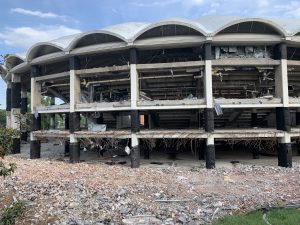U-Hall: Expect A Big BOOM On Saturday
By Jerry Ratcliffe
 If you haven’t had the chance to get a last glimpse of University Hall, make it a priority in the next few days.
If you haven’t had the chance to get a last glimpse of University Hall, make it a priority in the next few days.
Home of Virginia basketball and most of the athletic department from its christening on Nov. 21, 1965, until the end of the 2005-06 season, the grand dame will come tumbling down in a mid-morning implosion on Saturday (May 25).
University officials strongly advise against the public coming out to the footprint of the implosion zone. There is no public viewing area to watch the event, which will be streamed live on UVA’s Facebook site (Virginia Cavaliers). Roads and surrounding garages will be closed and there will be a police presence blocking the public from the area.
According to Joshua Campbell, president of Renascent (the demolition company hired to bring down the building), the 10 a.m. implosion will bring down the support columns that are propping up the 5,000-ton concrete clam shell-shaped roof that made the arena so distinctive on the Charlottesville skyline.
Over the life of the building, Virginia basketball players jokingly referred to U-Hall as “the pregnant clam.”
The greatest Cavalier of all-time, Ralph Sampson, is expected to push the button that will bring “Ralph’s House” to the ground. Sampson was a three-time National Player of the Year who helped UVA post a 50-2 record in the building during his career.
U-Hall was tabbed “Ralph’s House” during his official visit to UVA, and someone painted those words on the arena roof.
There is a rumor that former UVA women’s great Dawn Staley will be part of the ceremony, but that has been unconfirmed.
Campbell said that the reason his company decided to bring the building down via implosion had more to do with a support ribbon circling the top of the building, just under the roof. That band of concrete, measuring six to eight feet wide and three feet thick, was added in 1997 or ‘98 according to UVA, to strengthen support of the roof.
“We have removed a lot of nonessential elements out of the building, nonstructural, non-load bearing walls, things that are not helping the structure stand,” Campbell explained. “We want to strip it all the way down to its bare frame and from there we actually will weaken some of the structure, then we go in and drill holes into those structures where the explosives will be loaded.”
He could not reveal how much explosives are required but said it is surprisingly less than one would think.
“Some people think that we just go in and strap some dynamite on like in the cartoons and it blows up,” Campbell chuckled. “There’s a lot more science and engineering that goes into it.
“The charges are actually all timed down to the millisecond as to how they are going to go off and in what order they’re going off, and that’s to create movement. We’re not trying to blow it up into a bunch of little pieces.”
Movement is used to create the direction the crew wants the structure to fall.
“We’re trying to weaken the building beyond what it can handle in its own weight and let the weight of the structure itself bring it down,” Campbell said.
Demolition crews are surrounding much of the outside of the building with a large curtain, a combination of chain link fencing and textile fabric that will help contain flying debris and dust when the building comes down.
Campbell said there will be a countdown for a plunger in the VIP area and other mechanisms going on that is closer to the structure itself. Residents and others in the area will hear a large “boom,” followed by a large dust cloud over top the structure (a normal occurrence). Prevailing winds will determine how long that dust cloud remains, approximately five to 10 minutes without wind, closer to five if the wind is blowing.
U-Hall will be reduced to a heap of glorious rubble that will be cleaned up over the next few months and recycled.
All asbestos was cleared out of the building during the first three months of the project and has passed inspection. The company said it puts safety first in all its projects.
Campbell said Renascent, based in Indianapolis, is excited to handle the project.
“Our name means ‘new birth,’ which is what we bring to a lot of projects, communities, and universities,” Campbell said. “It’s a new chapter that’s going on in a certain place.”
UHall, Onesty Hall, and The Cage are being removed to make way for UVA’s “Master Plan” for the athletics department. Those three buildings will be replaced by two grass practice fields and one all-purpose field.
“Currently our football program does not have a grass practice field,” said Jim Daves, associate athletic director for media relations. “We believe we’re the only Power 5 conference school in the country that doesn’t have a grass practice field.”
Daves said that when UVA wants to practice on grass, which is believed to be more forgiving for knees and ankles, it must go to either Lambeth Field (the school’s football field that was used until 1931) or to Scott Stadium. The Cavaliers’ present practice field and the field at the George Welsh Indoor facility are field turf.
“There’s something about a building coming down suddenly … it’s just fun,” Campbell said. “It’s not a 300-foot tall building but it’s still a very large structure and an iconic structure to the area. There’s a lot of people that recognize the building and have spent a lot of time in the building.”
A lot of memories, some of the greatest memories in Virginia sports history, took place in that building. We will relive some of those as the week goes on leading up to the implosion.
Meanwhile, UVA announced that it had partnered with Artsman (artsmansport.com) to produce memorabilia from University Hall and the Cavaliers’ 2019 national championship.
Artsman will create a collection of commemorative artifacts from the University Hall basketball floor used from the mid-1980s to 1997 (framed showcase pieces), and additionally from the national championship court.








